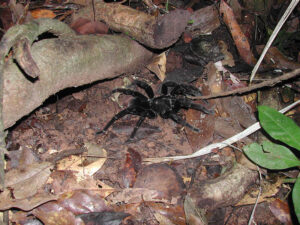All though average room temperature (18-20C) is sufficient for most spiders a daytime temperature of 24-27C is preferable. The ideal is to heat up a entire room but if you do not have the space you can use low watt bulbs (max 25W) or a heating pad. In a smaller cage you should try to avoid bulbs for heating because the cage overheat easily. Heating pads can be used in a smaller cage under the cage if its a arboreal set up and on the backside if terrestrial. Heating cables can also be used in the same way as heating pads. The other alternative as mentioned earlier is to heat up the entire room. Then you can place the cages higher up for a warmer temperature and lower if they need somewhat cooler temps.

Above: Pamphobeteus species found under rocks with bone dry gravel/sand under a rainforest lodge in Peru. The humidity is high enough so the spider can thrive in such conditions.
If you keep the spider too dry it can get problems when its time to molt especially if its a rainforest species. Think of where the spider originates from. The rainforest of South America or a dry african savanna? If you find your spider frequently sit over the waterdish its a clear sign you keeping it too dry and the spider tries to moisten the booklungs over the dish. Increase the humidity by pouring water direct on the substrate. On the other hand, if its too moist in the cage the spider can develop spots of mould on the body (especially in combination with poor ventilation) and even legs can fall off as a result. Try to keep part of the cage a bit drier so the spider can choose to be in the drier or moist part.

Above: The same species as the picture above – Pamphobeteus ssp. where they usually are found on the rainforest floor.
